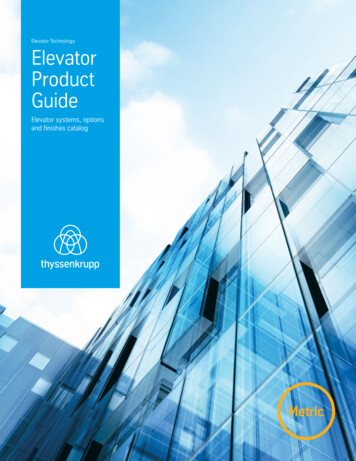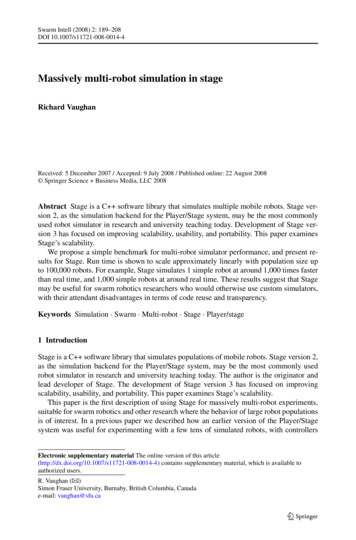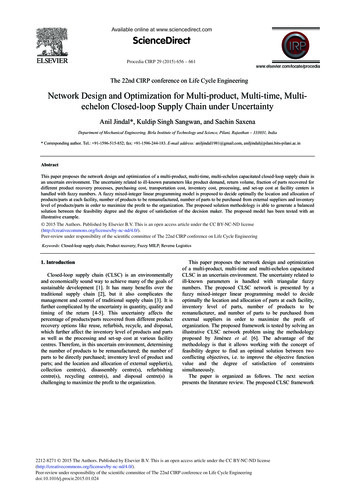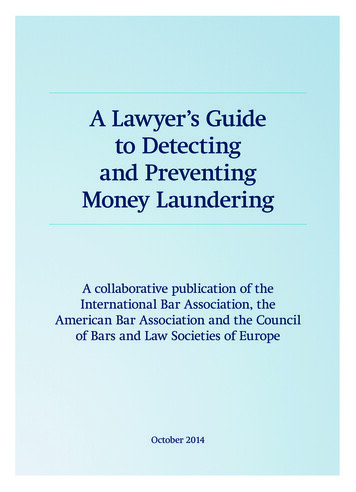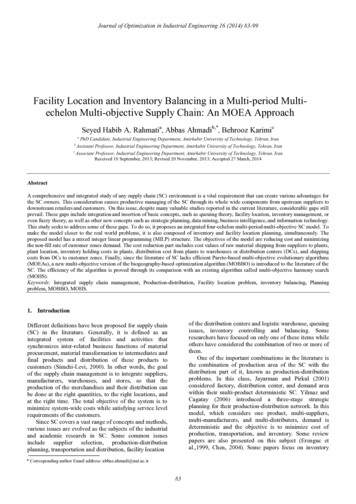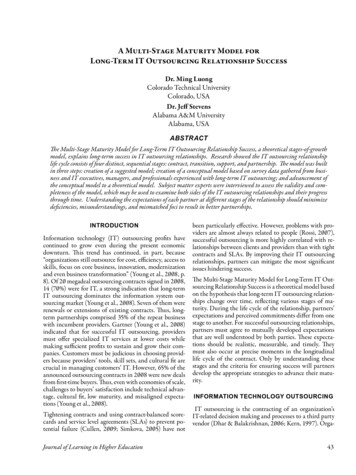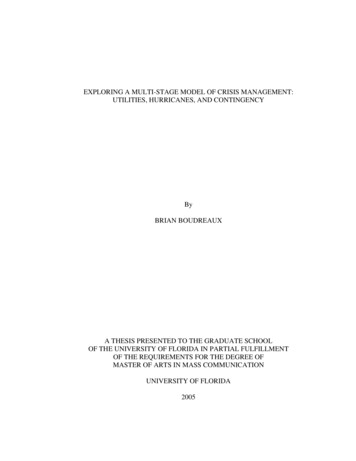
Transcription
EXPLORING A MULTI-STAGE MODEL OF CRISIS MANAGEMENT:UTILITIES, HURRICANES, AND CONTINGENCYByBRIAN BOUDREAUXA THESIS PRESENTED TO THE GRADUATE SCHOOLOF THE UNIVERSITY OF FLORIDA IN PARTIAL FULFILLMENTOF THE REQUIREMENTS FOR THE DEGREE OFMASTER OF ARTS IN MASS COMMUNICATIONUNIVERSITY OF FLORIDA2005
Copyright 2005byBrian Boudreaux
ACKNOWLEDGMENTSI would like to thank my chairman, Dr. Michael Mitrook, for his guidancethroughout this project. His insights, support, and candor were fundamental to thecompletion of this study. Additionally, my committee members, Dr. Peg Hall and Dr.Jennifer Robinson, provided a refreshing view of this piece that will not soon beforgotten. Lastly, I would like to thank my family for their continued support of myacademic endeavors. This would not have been possible without their never-endingsupport.iii
TABLE OF CONTENTSpageACKNOWLEDGMENTS . iiiLIST OF FIGURES . viABSTRACT. viiCHAPTER1INTRODUCTION .12REVIEW OF LITERATURE .3Reality of a Crisis .3Issues Management.4Models of Crisis Management.7The Contingency Theory of Accommodation .14Criticisms of Contingency Theory .16More on Advocacy .17More on Accommodation.18Contingency Variables .19Predisposing variables.19Situational variables .223METHODOLOGY .26Review of Research Questions .26Data Collection .26Sample .28Data Analysis.294RESULTS AND DISCUSSION.30Phase 1 .30Phase 1.1.31Phase 1.2.34Phase 1 Conclusion.35Phase 2 .36Phase 2.1.37iv
Phase 2.2.38Phase 2 Conclusion.40Phase 3 .41Phase 3.1.41Phase 3.2.42Phase 3 Conclusions .435LIMITATIONS AND FUTURE STUDY .446SUMMARY AND CONCLUSIONS .46APPENDIXAE-MAIL RECRUITMENT LETTER .53BBIOGRAPHICAL INFORMATION.54CPRIMARY QUESTION FORMAT .57DFOLLOW-UP QUESTION FORMAT.58ESAMPLE REMINDER E-MAIL.59FPHASE 1.1 QUESTION AND RESPONSES.60GPHASE 1.2 QUESTION AND RESPONSES.63HPHASE 2.1 QUESTION AND RESPONSES.65IPHASE 2.2 QUESTION AND RESPONSES.67JPHASE 3.1 QUESTION AND RESPONSES.69KPHASE 3.2 QUESTION AND RESPONSES.71LIST OF REFERENCES.72BIOGRAPHICAL SKETCH .75v
LIST OF FIGURESpageFigure1Crisis Management: Strategic Considerations .82The Crisis Life Cycle .93Development of Issues with or Without Management Intervention .94Advocacy-Accomodation Continuum.145Contingency Variables in Crisis Management.51vi
Abstract of Thesis Presented to the Graduate Schoolof the University of Florida in Partial Fulfillment of theRequirements for the Degree of Master of Arts in Mass CommunicationEXPLORING A MULTI-STAGE MODEL OF CRISIS MANAGEMENT:UTILITIES, HURRICANES, AND CONTINGENCYByBrian BoudreauxMay 2005Chair: Michael MitrookMajor Department: Journalism and CommunicationsThe purpose of this study was to explore the three-stage model of crisismanagement and determine what influence the contingency theory of accommodation’shighly-supported-predisposing and situational variables have on crisis management.This qualitative study examines crisis management practices of municipal utilitycompanies in the state of Florida. Participants discussed their organization’s crisismanagement practices in conjunction with the very active 2004 hurricane season. Amodified Delphi study was used to collect data from senior-level public relations andcorporate communications professionals from a cross-section of state municipal utilitycompanies. Primary and secondary questions referencing each stage of the three-stagemodel of crisis management were generated to identify the variables that most affectedorganizational crisis management.The findings expose a relationship between the highly-supported-predisposing andsituational variables of the contingency theory and the three-stage model of crisisvii
management. This study serves as a springboard for future quantitative research that maybe able to generate a statistical correlation between the contingency theory’s highlysupported variables and the three-stage model of crisis management.viii
CHAPTER 1INTRODUCTIONManaging crises is a vital aspect of public relations practice as all organizationsexperience them. As one practitioner explains, “no one is immune. Crises are nondiscriminatory. They don’t care who gets in the way. It’s not a matter of ‘if,’ in mostcases, but simply ‘when.’” (Wilson, 2004, paragraph 2). Likewise, L. Grunig, J. Grunigand Dozier (2002) asserted, “Regardless of the model of public relations practiced or theexpertise of the communicator, crises inevitably befall organizations” (p. 473).Thebelief that a crisis situation will not strike an organization must change; the mentalitymust shift from if, to when. Indeed, crises are a reality that companies, governmentagencies and nonprofit organizations alike must recognize. The incidence of crises is nota new phenomenon, but increasingly catastrophic results have validated their relevance inpublic relations.The ubiquitousness of crisis situations necessitates the creation of a widelyaccepted model of a crisis management that provides organizations the framework toassist in the survival of a crisis event. Though there are models that explore crisismanagement, these models have yet to include a concrete theoretical underpinning. Thisqualitative study attempts to begin grounding the three-stage model of crisis managementin the contingency theory of accommodation.The researcher believes that the contingency theory’s highly-supportedpredisposing and situational variables, identified by Cancel et al. (1999), will emerge asinfluential to crisis management. The researcher proposes that the predisposing variables1
2will appear in the participant responses during precrisis stage while the situationalvariables will emerge in the crisis stage of the three-stage model of crisis management.This study will test this hypothesis while also exploring the role of the contingencytheory variables in crisis management.
CHAPTER 2REVIEW OF LITERATUREReality of a CrisisAlthough all types of organizations are vulnerable to a crisis, certain industries areinherently more prone to a crisis event. L. Grunig et al. (2002) quoted a practitioner whorefers to the insurance industry as a “crisis by definition” (p. 473). Among the manyreasons cited by scholars and practitioners to prepare for a crisis is one advanced byHoward and Mathews (2000). Preparation is needed, they said, “. . .because you cannotcontrol the elements, human nature or the outside world” (p. 217). This statementoutlines the difficulty of crisis management; though practitioners and organizations canprepare for numerous scenarios, there are many more they have no control over.Before further discussion, the definition of a crisis must be established. Scholarshave defined the term crisis in a number of ways. As defined by Sapriel (2003), a crisisis “an event, revelation, allegation or set of circumstances which threatens the integrity,reputation, or survival of an individual or organisation” (p. 348). Shrivastava, Mitroff,Miller, and Miglani (1988) presented an in-depth definition of a crisis asAn organizationally-based disaster, which causes extensive damage and socialdisruption, involves multiple stakeholders, and unfolds through complextechnological, organizational, and social processes. (p. 285)Much of the literature discusses crises at the organizational level. In doing so, thedefinition of a crisis has focused on only a segment of crises. Pauchant and Mitroff(1992) developed a definition of a crisis that can apply to more than just organizationallybased events. The authors discuss a crisis as “a disruption that physically affects a3
4system as a whole and threatens its basic assumptions, its subjective sense of self, itsexistential core” (p.15). This definition encompasses non-organization crises, such asnatural disasters, that have an effect, not only on individual organizations, but rather acommunity system as a whole.Other scholars take a more basic approach to defining a crisis. Coombs (1999a)described a crisis as something that embarrasses or challenges an organization’s characterand that demands an explanation. González-Herrero and Pratt (1996) defined a crisis assomething that is simply “unwelcome and sudden” (p. 82). Lastly, Coombs and Holladay(2001) defined a crisis as “one event or interaction within a larger relationship betweenan organization and its stakeholders. . .[that can] damage or be a threat to a qualityrelationship” (p.324). Though the depths of definitions vary, they each employ the sameprinciple: A crisis is an event that can drastically affect the ability of an organization tosustain itself. This will serve as the definition of a crisis for discussion throughout thisstudy.A danger that organizations sometimes face is the issue of a perceived crisis.Organizations may leap into crisis management protocols for mere transgressions. Forexample, the resignation of an organization’s Chief Financial Officer alone is not a crisisand does not warrant the use of crisis protocols. If the resignation of a CFO is the resultof financial malfeasance, though, the organization should address the situation as apossible crisis. Organizations need to be able to differentiate between perceived and realcrises.Issues ManagementGonzález-Herrero and Pratt (1996) posit that a crisis is sudden. Although the onsetof a crisis can be sudden, there are situations when organizations are aware of and
5prepared for such an event. Though many factors influence the outcome of a crisis, Smitsand Ezzat (2003) posit that preparation is one of – if not the – most important steps in theprevention of a crisis, “Effective crisis management depends upon planning and people”(p. 2). Penrose (2000) stated, “Researchers tend to agree that organizations that practiceproactive crisis management will lessen the damage of a crisis” (p. 155). Indeed,González-Herrero and Pratt (1996) also explained that crises have early signals and,“ sensing potential problems is the first step toward avoiding or resolving them orminimizing their impact” (p. 82).Issues management helps an organization become aware of possible crises and planaccordingly. One facet of this awareness involves determining those publics which couldlead or contribute to a crisis. As J. Grunig and Repper (1992) explained, “Members ofactive publics, affect organizations more than passive ones because they engage inindividual behaviors to do something about the consequence of organizational actions”(p. 137). If an organization can identify these groups it can attempt to dispel orcounteract damaging behaviors.Issues management helps remove the unexpected and sudden factors of the crisis;the situation can be defused before it occurs. Moreover, information gathered will notonly allow practitioners to prepare, it will allow them the opportunity to realize andunderstand what preparations they cannot make. “Nothing prepares you for change betterthan the awareness of what you can do, and cannot do, about it” (Goodman, 2001, p.117). The occurrence of some events is uncontrollable, thus, practitioners should shifttheir efforts away from preventing such events and towards weathering them. Forinstance, a state is aware of a hurricane days before it makes landfall. Though issues
6management allows the opportunity to prepare for the possible crisis, it cannot neutralizethe storm. Instead, issues management allows practitioners to prepare for the event aswell as the resolution after the crisis occurs.Howard and Mathews (2000) describe issues management as a practice that goodmanagers have done for years; that it is a necessary part of effective planning. GonzálezHerrero and Pratt (1996) discuss issues management as a tool to identify and anticipatepotential issues before they are a threat. Thus, issues managers should be forwardthinking. The longer an organization is aware of the possible issue, the better it canprepare. Indeed, Ewing (1987) posits that issues managers should look 12 to 36 monthsahead.Issues management is often thought of as a proactive practice used to avoid anegative situation, though it can also identify positive opportunities. Practicing issuesmanagement improves an organization’s awareness of its community and ways topositively involve itself. For example, an organization can improve its standing in acommunity by being aware of and supporting an upcoming philanthropic event. Issuesmanagement can also present organizations with an opportunity to showcase its positivepractices.Unfortunately, preparation and issues management is sometimes not sufficient toavoid a crisis. Numerous incidents illustrate that although organizations were preparedfor an event, the crisis was still damaging. Examples of such scenarios can be seen in allprofessions: corporate, litigation, and nonprofit. Preparation, though valuable, is not aguarantee of success. The difficulties associated with a given crisis will impact theeffectiveness of the preparation. Burnett (1998) presents some difficulties crisis
7managers may face, they include too little data, too much data, and little planning. Thesevariables illustrate that simply having information and early preparation may not besufficient deterrents.Models of Crisis Management“The disparate volumes of crisis management information can be overwhelming”(Coombs, 1999b, 9). Certainly there are many factors a crisis management professionalmust account for in order to be successful. The organization of such information into auniversally accepted model has presented practitioners and scholars with a challenge.Burnett (1998) identifies both tasks and factors that compromise the ability of anorganization to practice crisis management (Figure 1). First, the author cited four factorsthat inhibit crisis management: time pressure, control issues, threat level concerns, andresponse option constraints. Burnett claims these factors, found on the outer-ring of themodel, disrupt an organization’s ability to focus on and strategically manage a crisissituation. According to this model, only when these four factors have been addressed canthe strategic management of the situation begin.Burnett (1998) divides the model’s six step inner-circle into three categories:identification, confrontation, and reconfiguration. The identification step is composed ofgoal formation and environmental analysis – the preparation for the crisis. Confrontationencompasses strategy formulation and strategy evaluation – the point when anorganization is involved in the crisis. Lastly, reconfiguration includes strategyimplementation and strategic control – how the organization adapts to crisis intervention.The author posits that during a crisis the difficulty of performing well in each categoryincreases. As illustrated by the model, employing the tasks that comprise the inner-circleprovides the organization an opportunity to control and manage a crisis situation.
8Figure 1: Crisis Management: Strategic Considerations; Adopted from Burnett (1998)Some models make the comparison of the crisis to a lifecycle (Fink, 1986;González-Herrero & Pratt, 1996). Inherent to this analogy is that the crisis has both abirth and a death. González-Herrero and Pratt (1996) discuss how crises follow asequential path through four phases: birth, growth, maturity and decline (Figure 2).Although this is an elementary model of a crisis, it is sufficient. It divides a crisisinto identifiable stages, it illustrates how a crisis changes over time, and that the cycledoes not end, rather that its effects linger beyond the decline and death of the crisis. Thisbasic model presents a simplistic, yet effective illustration of the crisis lifecycle.González-Herrero and Pratt (1996) expanded this model to illustrate the effect ofissues management in a crisis situation. By practicing issues management before crisisbirth, the authors believe organizations can shift the outcome of the crisis (Figure 3).Previously, the crisis would have reached maturity, to eventually decline into the postcrisis phase. In this adaptation of the model, issues management is shown to be effectiveas the planning stage results in the prevention of a crisis.
9Figure 2: The Crisis Life Cycle; Adopted from González-Herrero and Pratt (1996)Figure 3: Development of Issues with or Without Management Intervention; Adoptedfrom González-Herrero and Pratt (1996)Coombs (1999b) states that the three most influential staged approaches to crisismanagement are Fink’s (1986) four-stage model of a crisis lifecycle, Mitroff’s (1994)five-stage model, and the basic three-stage model.The three-stage model is unique in that no single scholar is attributed with itscreation. “The three-stage model is not associated with any particular theorists, but itappears to have emerged from several research efforts as a general analytical framework”
10(Seeger, Sellnow, and Ulmer, 2003, 97). Coombs (1999b) describes the three stages ofthe model – precrisis, crisis, and postcrisis – as macrostages that can be applied to manymodels of crisis management.The precrisis stage includes all aspects of crisis prevention – issues management,planning, and other proactive steps. The crisis stage refers to the steps taken to cope withand respond to the crisis event – crisis recognition, information distribution, messagedevelopment, reputation management, and evolving developments. The postcrisis stagebegins when the crisis is resolved – ensuring the crisis over, assuring publics of thesecurity of the organization, and learning from the event.Coombs (1999b) and Seeger et al. (2003) contend that the three-stage modelprovides a framework for the incorporation of various sub-stages which change based ona multitude of variables. The type and impact of the crisis, media coverage of the event,and the size and culture of the affected organization can all be influential factors.Coombs explains that both Fink (1986) and Mitroff’s (1994) models fit into the generalparameters of the three-stage model.Fink’s (1986) four-stage model examines a crisis as an extended event withsufficient warning signs that precede the event. Fink’s four stages are: the prodromalstage, the acute stage, the chronic stage, and the resolution stage. In the prodromal stage,the role of a crisis management professional is not reactive, but instead a proactiveapproach. In this stage, crisis managers attempt to identify an impending crisis. Thisinformation can be found in various places, such as internal and external audits,government legislation, and industry publications. Actions taken during the prodromal
11stage can easily be placed into the precrisis stage of the three-stage model as they addressan organization’s crisis prevention.Fink (1986) argues that the actual crisis event begins with a trigger, during what herefers to as the acute stage. This stage is characterized by the crisis event and resultingdamage. The severity of the crisis and damage are influenced by the success of theprodromal stage. Successful proactive identification of a crisis can reduce the impact ofthe crisis in the acute stage. Failed recognition in the prodromal stage creates a reactivesituation instead of a proactive intervention.The third stage of Fink’s (1986) model is the chronic stage. This stage refers to thelasting effects of the crisis. Although individual crises may occur quickly, the lastingeffects of the incident can extend the lifecycle of the crisis. Additionally, this stage mayinclude a barrage of questions about the crisis which will keep the event visible to variouspublics.For example, an individual event, such as a natural disaster, may occur quickly, butthe fallout of the incident make take weeks or months to repair. Individuals andorganization in Florida are still recovering from the 2004 hurricane season. Morerecently, entire countries are still dealing with the massive damage and loss of life causedby a tsunami that struck areas of Southeast Asia December 26, 2004. Coombs (1999b)states that the acute and chronic stages act as sub-stages of the crisis stage of the threestage model. These stages include the appearance of a crisis and the steps taken toresolve the crisis event, characteristics which are found in the crisis stage of the threestage model.
12The final stage in Fink’s (1986) model is the resolution stage. This stage identifiesa clear end to the crisis. Although organizations view this as the goal, it is not one to berushed to. An organization’s premature conclusion that the chronic stage has ended canleave them vulnerable to the resurgence of the crisis. Due diligence in the previousstages of the model must be practiced to insure such a regression does not occur. Thislast stage of Fink’s model parallels the postcrisis stage of the three-stage model as itensures the crisis has ended and distributes that message.The resolution stage does neglect one portion of the three-stage model. Fink doesnot discuss crisis management as a cyclical process. This is seen as one of the oversightsof the model, that what was learned from a previous crisis is not expressly discussed inplanning for future crises.Mitroff (1994) developed a model that divides crisis management into five stages:signal detection, probing and prevention, damage containment, recovery, and learning.The segmentation of the crisis parallels Fink’s (1986) discussion of the crisis lifecycle aswell as the three-stage model.The first two stages – signal detection and probing and prevention – encompass theproactive steps an organization can take before a crisis event. Signal detection identifiesthe signs of possible crises within an organization. Signal detection is much like Fink’s(1986) prodromal stage. Probing and prevention though is not addressed in Fink’smodel. This stage features members of an organization seeking known crises anddetermining ways to prevent them. While Fink implies that crises can be prevented,Mitroff’s (1994) model actively tries to prevent crises (Coombs, 1999b). As with Fink’s
13prodromal stage, signal detection and probing and prevention exemplify thecharacteristics of the precrisis stage.The last three stages of Mitroff’s (1994) model – damage containment, recovery,and learning – feature slight variations from Fink’s (1986) acute, chronic, and resolutionstages. Like Fink, Mitroff’s stages discuss the trigger and containment of the crisis event,the arduous task of returning to the pre-crisis norm, and the resolution of the crisis event.Damage containment, like Fink’s chronic stage, focuses on the steps taken following thecrisis event. A relationship can be made between damage containment and the crisisstage of the three-stage model as they both involve actions taken in response to the event.The differences between Fink and Mitroff’s models are found in the recovery andlearning stages.First, in the recovery stage Mitroff (1994) emphasizes the facilitation of theorganizational recovery whereas in the chronic stage, Fink (1986) states thatorganizations recover at varying rates. Mitroff emphasizes opportunities to empowercrisis managers in a particular crisis event while Fink focuses only on the timeframe ofthe recovery. As with damage containment, a relationship can be made betweenMitroff’s recovery stage and the crisis stage of the three-stage model. As in the crisisstage, during the recovery stage the organization works toward the eventual end of thecrisis.The second difference is that Mitroff’s (1994) model is cyclical. The learning stageallows an organization to incorporate what it has learned from the crisis into itsorganizational philosophy. Fink’s model simply states that resolution occurs when thecrisis is no longer a concern with no mention of future applications. Mitroff’s discussion
14of crisis management as a cyclical process is significant. The learning stage is essentialto the three-stage model. Like Mitroff’s five-stage model, the three-stage model iscyclical and recognizes the importance of applying what an organization learns during acrisis to future crisis events. The three-stage model and the five-stage model bothacknowledge that a failure to learn from a crisis can leave an organization susceptible tothe crisis again.The three-stage model of crisis management is the most widely accepted model,and thus, will serve as the backdrop for this study. Whereas a more specific model maybe relevant in follow-up studies, this initial study to explore crisis management practicesand identify the role of the contingency theory variables in crisis management willbenefit from the use of this widely accepted model.The Contingency Theory of AccommodationThe contingency theory of accommodation in public relations is based on thepremise that there are a number of variables that could affect the steps a public relationspractitioner may take when managing a particular situation. Cancel, Cameron, Sallot,and Mitrook (1997) identified 86 such variables that have the potential to influence thedecision making process, thus moving the stance of an organization along a continuumranging from pure advocacy to pure accommodation (see Figure 4).Pure - - - - - - - - - - - - - - - - - - - - PureAdvocacyAccommodationFigure 4: Advocacy-Accomodation Continuum; Adopted from Cancel et al. (1997)The advocacy portion of the continuum refers to those organizations or groups whostrongly represent one side of an issue. Cancel et al. (1997) made the comparison to an
15attorney’s repres
accepted model of a crisis management that provides organizations the framework to assist in the survival of a crisis event. Though there are models that explore crisis management, these models have yet to include a concrete theoretical underpinning. This qualitative study attempts to begin grounding the three-stage model of crisis management

